Preview of the operating system Windows Mobile 2005 (Magneto)
It turned out that we have an opportunity to get familiar with the new version of Windows Mobile operating system before the official announcement and long before the appearance of first devices based on the new OS. In the Internet there appeared the version of this OS for HTC Himalayas (the Qtek 2020, the I-mate Pocket-PC and others, we tested it on the Qtek 2020). Right away we’d stipulate that we won’t tell you in the forum or by e-mail where to download the update of the new operating system and how to install it. However we consider it our duty to introduce opportunities of the new operating system to our readers. The current version isn’t a final one, just preliminary. But taking it into account we can have an idea of the version, which will come out in the 3Q 2005. At the moment we have an opportunity to draw attention of developers to errors and weak points, perhaps they will listen to it, and improvements will be taken into account in the final version. Naturally, as soon as the final version of this operating system appears, we’ll publish the updated review.
Initially the announcement of the new OS was scheduled for February 2005. But later it was suspended presumably till the 2Q. The date might be changed for earlier or later terms, however under the preliminary info the release of the final version is set for April 13. As far as we learned, the release of devices powered by the new OS is expected in summer 2005. The project name à the new Windows Mobile is Magneto. Let’s recall project names of other Windows Mobile versions, and also the announcement dates.
- Windows Mobile 2005 – Magneto – not announced
- Windows Mobile 2003 Second Edition – Ozone Update – March 24, 2004
- Windows Mobile 2003 – Ozone –
June 23, 2003
- Pocket PC 2002 – Merlin –
October 4, 2001
- Pocket PC 2000 (Palm-size PC v2) – Rapier –
April 19, 2000
- Palm PC v1.0/1.2 – Gryphon/Wyvern – 8 ÿíâàðÿ 1998 ãîäà
January 8, 1998 (3 months later Palm PC renamed into Palm-size PC)
Currently the OS is called Windows Mobile 5. Most likely by the release Magneto will have the commercial name Windows Mobile 2005. The system requirements are as follows: 32 MB of Flash ROM, 64 MB of RAM. As for the processor, the old requirements are valid, i.e. Magneto will have acceptable performance at 200 MHz.
The operating system is based on the kernel Windows Compact Edition (WinCE) version 5.1. It differs from its predecessor in Direct3D Mobile (initially optimized for Wireless MMX), Windows Error Reporting, the possibility to work as a USB storage without drivers, improved support of Bluetooth and Wi-Fi and so on.
General changes
At the first launch the device asks to set a password (a simple 4-digits or stable, additionally you can enter the code prompt). It’s a step in the right direction, many just used default settings, that means the absence of any kind of protection. System sounds got also changed, now they are more pleasant. Besides, to say the truth, old sounds bore. Now system hints float from below, they no longer appear as clouds above.

On the face of it the interface hasn’t been changed, it looks almost the same. The cross at the top right corner has different design. As before it just minimizes launched application instead of closing them. The ideology implies that it is the OS that decides which applications the user needs at the moment and which to close, as they are idle (Smart Minimizing concept). The Start up screen looks the same, there are two standard themes available. On the top left you see «Start» button, to the right comes the indicators line, nothing has been changed – connection indicator (GPRS, Wi-Fi, Active Sync), cell network indicator, sound volume, time.
 
The changes of the interface are meant to provide a single-handed control of the device without using the touch screen. Below the screen there are two soft buttons (two inscriptions). It’s possible to assign them to any control buttons as you wish. Given this, the design of all built-in applications has been changed, all options are tied to the soft buttons. At the Start up screen the bottom icons are placed a line above including Bluetooth manager, Wi-Fi and other icons. See the screenshots below to compare interfaces of Magneto (right) and WM 2003 SE (left).
 
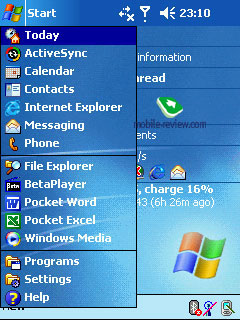 


Another moment that facilitates the control of the device without using the stylus is the improved navigation of the joystick, its functionality used to be restricted. We’d provide an example with GPRS settings. Press start button to launch Start menu. Double «Up» and «Enter» to go to Settings. Four times «Up» (Settings bookmark), double «Right» (Connections bookmark), double «Up» and «Enter». Here we change settings and press «OK». With the previous OS you could do it only with the help of the stylus, now hardware buttons can handle it. This method can be applied to other actions – various scrolling functions (screen brightness, for example), ticking in check boxes, field movements.
 
The consequences of changes are evident. After QVGA screens became the feature of smartphones, there is no need in a separate operating system Windows Mobile for Smartphone. There is little sense in the support of two OS (Windows Mobile for Smartphone and Windows Mobile for Pocket PC), when a single OS combines opportunities of the both. This division was justified by two factors. Firstly, it’s the restriction by screen resolution. Secondly, old Pocket PC and Windows Mobile versions were incapable to operate the device by means of the joystick and the digital keyboard.
Outlook Mobile
One of the key tasks for a handheld PC is to organize contacts, work schedule, tasks and notes. We’d add e-mail to the list. Naturally, all this stuff should be smoothly synchronized. Pocket Outlook has every means to carry it out. A part of applications from the package got improved, another part experienced no significant changes.
 
 
 
Contacts. The key change here is that now you can attach a photo to a contact. This function emerged in the desktop version MS Outlook 2003, and it logically moved to the mobile version. Contacts opportunities stay at the same level with the desktop PC analog. In the previous version of Window Mobile there were 29 fields to fill in plus a text note. In Magneto you can assign photos and attach personal melodies to separate contacts. There are 37 fields available (additional fields include IM, Company Tel, IM2, IM3, Manager, Govt. ID, Account, Customer ID) and a text note (only for texts, it’s no longer possible to draw or make a voice memo). It’s impossible to rename the fields, like in desktop version. It can hardly be a weak point, as 37 fields are more than enough, and if something didn’t find its field, you can add it as a text note. We faced no problems with synchronization, even with the Russian language.
 
 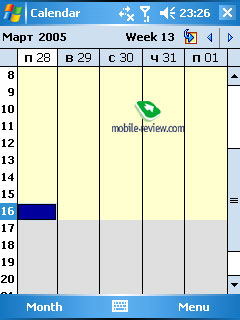
 
 
 
 
Calendar. This application will assist you in making schedules, its opportunities haven’t changed. There are 4 modes available – Day, Week, Month, Year. The synchronization with desktop PC ran smoothly. As before, Calendar lags behind desktop MS Outlook in its functions, the mobile version is much simplified.
 
 
Tasks. This application is used to schedule tasks. It’s extremely simple and has cut-off functionality against its analog on PC. You can set only terms, priority, task indicator, reminder and category. It’s impossible to set the task completion percentage. The synchronization runs smoothly.
 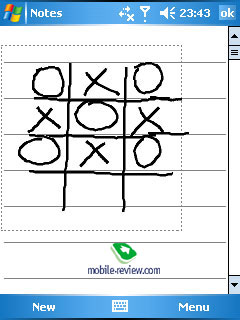
Notes. You can write notes by hand, use a voice recorder or type the text from a virtual keyboard. The handwritten text can be recognized (only Latin symbols). There is an opportunity to synchronize notes with desktop Outlook.
 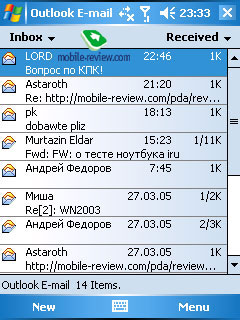
 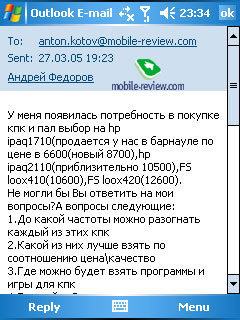

Messages. Unfortunately, nothing significant happened to it, as before it doesn’t display HTML in letters – only the text. Design is slightly different (colors of the heading). The developers solved the problem with incorrect view of Cyrillic title, now letters can be displayed in local encodings without any problems. You can set auto encoding identification or choose it manually. Deleted letters can’t be re-downloaded, but the letters aren’t deleted from the server. If there were no problems with local encodings, we’d advise you an alternative e-mail client Web IS Mail 2 (no problems with Latin symbols). Unfortunately, there is still no worthy substitute for this e-mail client.
 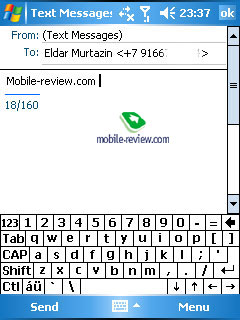

Text messages can be found here. Everything is standard. In the settings you can activate delivery status by default, earlier we had to run the same procedure for each message, which was very inconvenient.
A worthy alternative to Outlook Mobile (contacts, calendar, tasks, notes, except for e-mail) can be Pocket Informant and Agenda Fusion packages.
Office Mobile
The version of MS Office for PDA is renamed from Pocket Office to Office Mobile, as well as applications from the package. Besides we see significant changes: from global changes in Word Mobile and Excel Mobile to emergence of PowerPoint Mobile. I’d note, the developers refused from the compact format for the documents, only desktop format is used. Let’s start.
 
 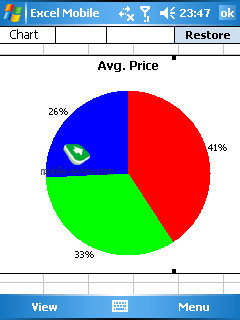

Excel Mobile. The main innovation here is the support of diagrams (6 types of diagrams available). Other features remain almost the same. There is zoom function and full screen mode, it’s possible to freeze panes. You can add/remove interface elements. For example, hide right scrolling bar, hide status bar and so on. Thus, a worksheet is displayed at a large screen surface. Now let’s create a new Excel document with a complex formatting (the second sheet depicts a diagram) and try to edit the document in Window Mobile 2005 and previous OS version (Pocket Excel).
Initial file created in MS Excel 2003>>>
File edited in Pocket Excel, WM2003 SE>>>
As you see, the link to the review disappeared, the inserted picture with the logo disappeared, merged cells undid, text in italics got straight, and the most important here – the diagram disappeared from the second sheet. The rest of formatting is kept, there is no problems with fonts.
File edited in Excel Mobile, WM2005>>>
In this case the same story, but the diagram remained and now it looks slightly different. In all, there are many format losses, but they aren’t that crucial. The main problem with the support of diagrams and charts is solved (in restricted variant you’ll hardly make a 3D chart).


Word Mobile. This built-in text application experienced great changes. Firstly, as in case with Excel Mobile the developers refused from Pocket Word Document format. The opportunities to create a new document are like in previous versions – simple formatting of texts, paragraphs, lists, it’s impossible to insert pictures, not to mention complex formatting. However when it comes to editing of ready files, the differences are drastic.
Initial filed created in MS Word 2003>>>
File edited in Pocket Word, WM2003 SE>>>
As you see, almost all formatting is lost (header and footer, tables, fonts, comments and so on). The Russian text is clumsy displayed. Let’s have a look at changes in Magneto.
File edited in Word Mobile, WM2005>>>
As you see almost all formatting is kept, including comments, tables and pictures. The document kept the style. What is lost – only correction comments and auto shapes, including pictures inserted as auto shapes. In result, we’d mark significant changes, however something is left to work over it.



PowerPoint Mobile. It’s a new application in the package designed to view presentations, it’s impossible to edit them. PowerPoint Mobile runs smoothly displaying pictures and basic graphics. Large files are downloaded very quickly.

Calculator. Everything is quite standard about it, nothing innovative. It’s an ordinary calc no more.
Internet
Internet Explorer. Evident changes involve the icon of the protected connection, it is located to the left from the address line. An additional line at the bottom of the screen displays the page downloading status.
 
The page processing engine hasn’t changed, but now you can access the full screen mode. Another innovation is that you can save pictures. It’s possible to stretch almost any page into a column («single column» mode, 3 modes available), without landscape scrolling. There is just one, but serious shortcoming – it’s impossible to open several pages simultaneously. We’d name its alternative, MultiIE. It’s rather a built-up for Internet Explorer, which extends its opportunities. Currently there is no integrated Internet-pager, thus we don’t speak about it. There is another built-in application Terminal Service Client to access the remote desktop.

Download Agent is a new application, which logically and easily automates downloading of software updates directly to the device. Unfortunately, we had no opportunity to try it.Multimedia
Windows Media of version 10 was also available in Windows Mobile 2003 Second Edition, however for just few devices. Now it becomes a standard. Its main destination is to be an addition to the desktop WM 10 and get synchronized with it via Active Sync.
 
As for its weak points, there are no equalizer settings, it’s impossible to assign the functions to the buttons in the standby mode (this opportunity was supported in previous versions). We advise you to use a freeware application Beta Player to play video, which has no match among the competitors.
 
Picture & Video (earlier called just Pictures). This is a simple program to view photos and run video clips taken by the built-in or external digital camera. There are plenty of alternative photo viewers on the market, which surpass the built-in program. However if you don’t require much from the viewer, this one will do.
 
File Explorer. It’s a simple file browser, which is easy to manage. File Explorer is designed to carry out only main operations with files.
PhoneIt’s a part of the operating system, which is responsible for phone functions. There are no fundamental changes, only application design got different. Key moments remained the same. You dial the number from the screen digital keyboard. During the call you can make a note and record the talk. After the call is ended you see its duration. In the standby mode you can see a recent call – incoming or outgoing (the number, the name and the photo, if there is any).
 

Speed Dial. You need to create the speed dial list by yourself. When you hold a virtual button for several seconds, one of nine numbers is dialed.
 
Call History. The main shortcoming of Call History was that the entries couldn’t be grouped by callers. That means, if you tried to dial a number 20 times, there will be 20 entries with the same number in the list, so it’s difficult to orientate in that history. Unfortunately, the problem is not solved in Magneto.
In the phone settings you can choose wav, wma, mp3 files for the ring tone (the files should be stored in Windows/Rings folder). The following call types are available: simple ring, increasing ring, single ring, vibrating alert, vibrating alert plus ring, vibrating alert followed by ring.
 
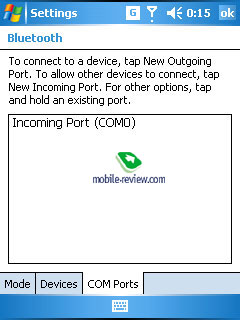
Settings, built-in drivers
Bluetooth. The implementation of this wireless standard (built-in drivers) still remains in embryo. Some attempts to improve built-in stack have been made, but they are far from what we can see in drivers offered by Broadcom (used in all mid range and high-end models).

There is an integrated utility responsible for the camera (photos and video). It is included into Picture & Video package.
 
We’d also note GPS drivers.

The approach to memory use has been altered. Now RAM is meant only for main memory, it’s no longer possible to install applications to RAM. Now you shouldn’t worry about the data loss, which can occur because of the drained battery, all the data is stored in flash memory.

The last thing in the assessment is Error Reporting utility. It gathers and sends to Microsoft all the info on errors, this system exists in desktop Windows for a long time. It’s possible to disable the utility.
ActiveSync 4.0
It’s the new version of the program to synchronize data with PC. According to synthetic tests the synchronization speed increased slightly by 10-15%. As I sensed it the data access speed has soared. In case of a break in synchronization the next connection will resume the process from that point. It’s quite comfortable.
 
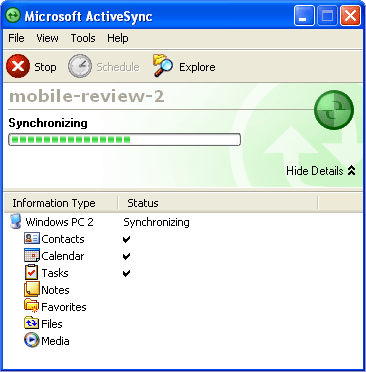

The synchronization settings got wider. You can choose contact groups for synchronization and exclude separate contacts from the process. The same is true for Calendar and Tasks. To synchronize e-mail you can choose folders and subfolders. Besides you can notice that the interface of the program changes, when another Windows Mobile 2005 device is connected (it stays the same in case of earlier OS versions).
In result
Operating systems based on Windows CE have already outpaced any other operating system taking into account the share on the PDA market. Windows Mobile Magneto will assist Microsoft in strengthening the position on the OS market for smartphones/communicators. Now it’s a common operating system, which replaces Windows Mobile for Pocket PC and Windows Mobile for Smartphone. There is no need in the latter any longer, it will leave the market during this year. The fact speaks for itself, applications for Windows Mobile 2003 for Smartphone can be launched and work on Magneto.
 
Main innovations in Windows Mobile 2005:
- The single-handed control of the device, not involving the touch screen. The support of applications for Windows Mobile 2003 for Smartphone. The key devices that will illustrate this approach this year are Asus p515, HTC Blizzard and Samsung Thor.
- Possibility to add photos and assign personal melodies to the contacts.
- Greatly improved Word Mobile (it keeps formats while editing, shows pictures); to a smaller extent – Excel Mobile. New application added – PowerPoint Mobile.
- Built-in drivers (APIs) for GPS and the camera.
As for the shortcomings, all of them are clearly shown in the review. I hope sincerely, the developers could read this review and draw some conclusions. Naturally, as soon as the final commercial version of this operating system appears, we’ll publish the updated review.
Anton Kotov (anton.kotov@mobile-review.com)
Translated by Anja Rytchkova (anja.rytchkova@mobile-review.com)
Published - 31 March 2005
Have something to add?! Write us... eldar@mobile-review.com
|

















































































